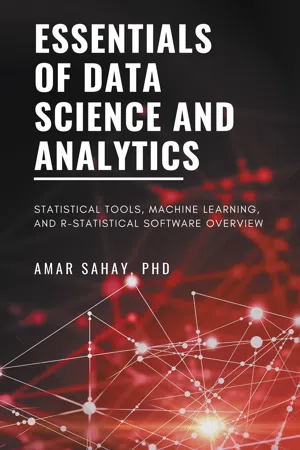Technology & Engineering
Data Analysis in Engineering
Data analysis in engineering involves the systematic process of inspecting, cleaning, transforming, and modeling data to extract useful information and make informed decisions. It encompasses various statistical and computational techniques to interpret and analyze complex engineering data sets, enabling engineers to identify patterns, trends, and insights that drive improvements in design, performance, and decision-making processes.
Written by Perlego with AI-assistance
Related key terms
1 of 5
6 Key excerpts on "Data Analysis in Engineering"
- eBook - PDF
- Douglas C. Montgomery, George C. Runger, Norma F. Hubele(Authors)
- 2014(Publication Date)
- Wiley(Publisher)
Consequently, engineers must know how to efficiently plan experiments, collect data, analyze and interpret the data, and understand how the observed data are related to the model they have proposed for the problem under study. The field of statistics involves the collection, presentation, analysis, and use of data to make decisions and solve problems. Statistics is the science of data. Definition Many aspects of engineering practice involve collecting, working with, and using data in the solution of a problem, so knowledge of statistics is just as important to the engineer as knowledge of any of the other engineering sciences. Statistical methods are a powerful aid in model verification (as in the opening story for this chapter), designing new products and systems, improving existing designs, and designing, developing, and improving production operations. Statistical methods are used to help us describe and understand variability. By variabil- ity, we mean that successive observations of a system or phenomenon do not produce exactly the same result. We all encounter variability in our everyday lives, and statistical thinking can give us a useful way to incorporate this variability into our decision-making processes. For example, consider the gasoline mileage performance of your car. Do you always get exactly the same mileage performance on every tank of fuel? Of course not—in fact, sometimes the mileage performance varies considerably. This observed variability in gasoline mileage depends on many factors, such as the type of driving that has occurred most recently (city versus highway), the changes in condition of the vehicle over time (which could include fac- tors such as tire inflation, engine compression, or valve wear), the brand and/or octane num- ber of the gasoline used, or possibly even the weather conditions that have been experienced recently. These factors represent potential sources of variability in the system. - eBook - PDF
Experimental Combustion
An Introduction
- D. P. Mishra(Author)
- 2014(Publication Date)
- CRC Press(Publisher)
As mentioned earlier, data analysis is the process of synthesizing and analyzing experimental data with the intent to unravel useful information and derive meaningful conclusions. But before deriving any conclusions from experi-mental data, it is essential to ascertain the quality of the data produced during experimentation. Recall that we try to measure the value of a physical quantity. In order to assess the quality of experimental data we will have to determine how the measured data deviates from the actual value of the physical quantity being measured. We will have to use our common sense in consistently recognizing certain patterns while acquiring the measured data. For example, temperature will increase with the addition of heat to a system. If some data point defies this common sense, it may be eliminated before carrying out any further data analy-sis. But if more data in an experiment defy common sense consistently, we need to review the entire experimentation procedure diligently. After examining the experimental data for consistency using common sense or previous theories, we need to carry out statistical analysis, particularly when experiments are repeated several times, which will help us to determine the level of confidence. Once con-fidence in the acquired experimental data is obtained, it is important to deter-mine the uncertainty level that can be stated along with the experimental data. It must be emphasized that the experimental data must be visualized properly to reveal inherent concepts, phenomena, patterns, or hypotheses lying hidden in the experimental data. For this purpose, it is customary to have a hypothesis based on either previous theory or antithesis. Certain physical nondimensional terms are used for deriving a better understanding of experimental data. - eBook - ePub
Essentials of Data Science and Analytics
Statistical Tools, Machine Learning, and R-Statistical Software Overview
- Amar Sahay(Author)
- 2021(Publication Date)
- Business Expert Press(Publisher)
Statistics is the science and art of making decision using data. It is often called the science of data and is about analyzing and drawing meaningful conclusions from the data. Almost every field uses data and statistics to learn about systems and their processes. In fields such as business, research, health care, and engineering, a vast amount of raw data is collected and warehoused rapidly; this data must be analyzed to be meaningful. In this chapter, we will look at different types of data. It is important to note that data are not always numbers; they can be in form of pictures, voice or audio, and other categories. We will briefly explore how to make efficient decisions from data. Statistical tools will aid in gaining skills such as (i) collecting, describing, analyzing, and interpreting data for intelligent decision making, (ii) realizing that variation is an integral part of data, (iii) understanding the nature and pattern of variability of a phenomenon in the data, and (iv) being able to measure reliability of the population parameters from which the sample data are collected to draw valid inferences.The applications of statistics can be found in a majority of issues that concern everyday life. Examples include surveys related to consumer opinions, marketing studies, and economic and political polls.Current Developments in Data AnalysisBecause of the advancement in technology, it is now possible to collect massive amounts of data. Lots of data, such as web data, e-commerce, purchase transactions at retail stores, and bank and credit card transaction data, among more, is collected and warehoused by businesses. There has been an increasing amount of pressure on businesses to provide high-quality products and services to improve their market share in this highly competitive market. Not only it is critical for businesses to meet and exceed customer needs and requirements, but it is also important for businesses to process and analyze a large amount of data efficiently in order to seek hidden patterns in the data. The processing and analysis of large data sets comes under the emerging field known as big data, data mining, and analytics.To process these massive amounts of data, data analytics, and mining use statistical techniques and algorithms and extracts nontrivial, implicit, previously unknown, and potentially useful patterns. Because applications of data mining tools are growing, there will be more of a demand for professionals trained in data mining. The knowledge discovered from this data in order to make intelligent data-driven decisions is referred to as business intelligence and business analytics - eBook - PDF
Automation for Food Engineering
Food Quality Quantization and Process Control
- Yanbo Huang, A. Dale Whittaker, Ronald E. Lacey(Authors)
- 2001(Publication Date)
- CRC Press(Publisher)
49 chapter three Data analysis Analysis of acquired data is an important step in the process of food quality quantization. Data analysis can help explain the process it concerns. Also, the analysis is beneficial for determining whether the available data is usable to extract the information to fulfill the goals in problem solving. In general, there are two kinds of data analysis. One is the analysis for static relationships, called static analysis. For example, in food quality classification and predic-tion, the functions between input and output variables are usually static. That is to say, such input and output relationships may not vary with time. The other kind of data analysis, dynamic analysis, seeks dynamic relationships within the process. This second kind is usually needed for food quality process control because in food process modeling and control, the relationships that are mainly dealt with are dynamic. This means that these relationships change with time. In this chapter, these two kinds of data analysis, static and dynamic, will be discussed with practical examples in food engineering. Images are an important data type in food engineering applications. Image analysis is conducted through image processing. In this chapter, image processing will be discussed for the purpose of image analysis. Through image processing, image pixel values are converted into numerical data as the input parameters to modeling systems. 3.1 Data preprocessing Before data analysis, data preprocessing is necessary to remove “noise” from the data to let analysis and modeling tools work on “clean” data covering similar ranges. In general, data preprocessing involves scaling all input and output data from a process to a certain range and the reduction of dimensionality. Many tools of analysis and modeling work better with data within similar ranges, so it is generally useful to scale raw input and output data to a common mean and range. - Miriam Schapiro Grosof, Hyman Sardy(Authors)
- 2014(Publication Date)
- Academic Press(Publisher)
If you incorporate the statistical design into your plan of other aspects of the study you will be much more secure in working through the details of data analysis and interpretation and presentation of your findings; these procedures will be a natural, organic part of your argument. • [data analysis] should aid in the clarification of meaning. . . but the production of a statistical summary in some impressive and elegant form should never be the primary goal of a research enterprise. If no inferential statistical techniques are available to fit the problem, do not alter the problem in essential ways to make some pet or fashionable technique apply. Above all, do not jam the data willy-nilly into some wildly inappropriate statistical analysis simply to get a significance test; there is little or nothing to gain by doing this. Thoughtless application of statistical techniques makes the reader wonder about the care that went into the [study] itself. A really good [study], carefully planned and controlled, often speaks for itself with little or no aid from inferential statistics. 3 A Note on Word Usage Statistics has several different meanings. It refers to the portion of applied mathematics that deals with the theory and application of techniques for reduction, display, and analysis of quantitative data, and also to a particular computed value or values, (e.g., the mean, the F-ratio, the correlation coefficient). In this book, we use both and trust the usage is clear in context. Questions That Data Analysis Can and Cannot Answer Statistical techniques permit you to summarize many kinds of numerical data, and to describe in a neat and mathematically manageable fashion certain kinds of relationships or comparisons among two or more sets of data. You may be able to assign values to parameters in functions used for description- eBook - PDF
Reverse Engineering
Technology of Reinvention
- Wego Wang(Author)
- 2010(Publication Date)
- CRC Press(Publisher)
209 6 Data Process and Analysis Data process and analysis in reverse engineering are composed of system-atic assessment and quantitative evaluation. These are two independent yet interrelated processes. The assessment process identifies and collects relevant data from the earlier work through data acquisition. Data acqui-sition is a critical but tedious exercise in reverse engineering. In practice, engineers often collect as much data as they can for later analyses. The subsequent evaluation process collates, interprets, and analyzes the data obtained through assessment processes to draw statistical inferences and ensure quality performance of the new part produced by reverse engineer-ing. All the raw data should be attained by creditable methods based on scientific and engineering principles whenever feasible. The reliance on anecdotal data by indirect estimation might lead to further uncertainty in later analyses. Despite the advancement in statistics and other interpretive methods to present data in various formats and analyze the trends, one of the challenges still confronting many engineers in reverse engineering today is to correlate all the data from multiple sources into a logical conclusion. In reverse engi-neering we might need to determine the heat treatment schedule from hard-ness measurements and tensile properties, to decide the fatigue strengths from a set of test results, and to calculate grain size from the measurements based on grain morphology. No matter what techniques are used for data acquisition, the data have to be accurate and verified. Any inference thereby drawn from the data should be able to show a logical collaboration among the collected data. It is particularly important to collate the characteristic signatures in drawing any inference from the data. The surface texture of a component is a signature that provides crucial clues for the machining tools used in manufacturing.
Index pages curate the most relevant extracts from our library of academic textbooks. They’ve been created using an in-house natural language model (NLM), each adding context and meaning to key research topics.





